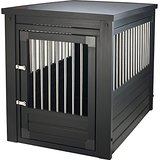 Using plastic or wire kennels for crate training puppies is both wise and safe. Letting your new puppy run loose in the house, doing whatever he likes, is irresponsible of you and dangerous for the pup. Puppies, like children, need boundaries to be able to learn and to be secure.
Using plastic or wire kennels for crate training puppies is both wise and safe. Letting your new puppy run loose in the house, doing whatever he likes, is irresponsible of you and dangerous for the pup. Puppies, like children, need boundaries to be able to learn and to be secure.
Even before you acquire a puppy you should consider which type kennel in which you would prefer to keep your dog secure. There are basically two types, wire and plastic. Each have their own merits and each will do the job. It is a personal choice. Some say that the plastic gives the puppy a greater feeling of security and of being in his “den”, which is something they like.
Before you bring the pup into your home, it’s a good idea to set his crate up and get it ready with all the necessary items. If it happens to have a tray at the bottom that slides out, you may want to put a towel or piece of material between it and the floor of the crate so it won’t shake when the puppy enters. This can frighten him right off the bat and make him afraid to go inside again.
Be sure to select the right sized crate for your puppy. If it is too large, he will use far corners for his potty and your efforts will fail, creating worse problems. If it is more economical to purchase a slightly larger one, be sure you can safely add a divider panel to it to create a smaller space. Puppies instinctively do not want to mess in their bedding areas. Use that to your advantage. Indeed, you can visit this to see the dog proof bins!
While he is in his crate, he does not need to have food and water in there with him. You will be feeding him frequently throughout the day. After feeding you will want to watch him closely for him “acting” like he needs to go potty, then take him outside immediately. Provide a few chew toys for the little mutt to play with in his “den” and maybe a towel or blanket to sleep on, if he likes that.
These furry little critters of eight or nine weeks can tolerate crating for up to seven or eight hours but it is not suggested that that be the norm, other than at night. For most times, a span of up to six hours can be well tolerated by Fido. Never use the crate as a place of punishment.
If it is possible to spend a few days of almost constant attention on the puppy in the beginning, that would be excellent. When you must go to work or leave the house for errands, if he has been taught the beginnings of good potty manners, he will be able to “hold it” for longer than you think. Try not to leave him kenneled for extended lengths of time. Be sure he gets out and has lots of exercise and attention. He will love you all the more for it.
When all is said and done, crate training puppies is a very effective way to teach your pup the rules of his life with you and your family. The crate will be used throughout his life to keep him and your home safe and secure. The rewards will be big, wet, sloppy kisses and a true friend forever.
Looking for more information about the steps to crate training, then visit TW Bell’s site on how to pick the best dog crate for your pets needs.
When you bring a new puppy home, can be a fun and delightful experience for the whole family. Nevertheless, familiarizing yourself with Crate training puppies and the steps that need to be taken in order to successfully reach your goals will probably be a good idea.
To begin, you should already have the crate in place and ready to go before you bring the puppy home. Papers, towels, or a doggy bed can be used for bedding inside the crate. Putting it somewhere near where you will be can be helpful in making the puppy feel more comfortable.
Keeping the cage close to where you are, can help the puppy feel more at ease, even when you’re away. For a while he will probably want to be with you all the time.
Make sure that the area is big enough for the puppy to move around in comfortably, but not too big. Puppies don’t like to go to the bathroom where they sleep, but if there is enough room they will be able to find a spot that they feel is suitable to relieve themselves. Toys and treats should be made available, at all times, to keep them occupied while they are confined. Water should also be available if the puppy is going to be in the crate for more than a couple hours.
Develop a routine of feeding. You can start to feed him in his crate right away, and get him used to it it. Food is a great incentive to a puppy’s hungry little tummy. If he is fed in the crate, he will start begin to recognize it as a place of enjoyment. After you feed him, wait about fifteen minutes and then take him out to relieve himself.
When you’re home, the crate should be open, but don’t force him into it, unless you have to leave. This area is supposed to be a place of comfort and security. If you punish him by sticking him in it, he will associate it with negative feelings and might possibly learn to fear it. This is not what you want. Nighttime and during the day when you have to leave the house are the only times when he should be in it for longer than a couple of hours.
While you are at home, keep the pup in his crate for an hour at a time. You may leave him in the room and watch television in another room, or get some housework done. There will most likely be some whining, and barking, but do not go into the room when he is making a fuss. When you no longer hear any cries, this will be a good time to go in and let him out. You must make sure to take him out regularly because puppies can’t hold it in for very long.
Crate training puppies takes time, and there will be accidents at first, but be patient and persistent. Never punish the puppy for soiling the crate, simply clean it up and continue with training. Given a little time, the puppy will learn to become very comfortable in his crate and most likely find it to be one of the most comfortable spots in the house
Looking to read more about the steps to crate training, then visit TW Bell’s site on how to pick the best dog crate for your pets needs.
 These days, air travel can be quite complicated. It can even be more complex when you are traveling by air with a dog or a cat. Make sure that you have bought Airline Approved Pet Carriers so you can make your trip easier. Of course, you also have to consider other factors such as the age of your pets, fees, veterinary advice, bradycephalic pets, and the local and state regulations depending on the location you’re heading to and connections. You also have to consider how long your flight will be.
These days, air travel can be quite complicated. It can even be more complex when you are traveling by air with a dog or a cat. Make sure that you have bought Airline Approved Pet Carriers so you can make your trip easier. Of course, you also have to consider other factors such as the age of your pets, fees, veterinary advice, bradycephalic pets, and the local and state regulations depending on the location you’re heading to and connections. You also have to consider how long your flight will be. There are many varieties that depend mainly on how active your pet is. There are some pets that are quite sedate and will do just fine in a small compact setting for the length of the flight. Other pets want more space and might like some bags that are like backpacks where the he can maybe even just adjust positions while inside the carrier. A lot of the containers that are of higher quality have various pouches will allow you to pack some other items for your pet, like a treat or maybe a toy for him to play with.
There are many varieties that depend mainly on how active your pet is. There are some pets that are quite sedate and will do just fine in a small compact setting for the length of the flight. Other pets want more space and might like some bags that are like backpacks where the he can maybe even just adjust positions while inside the carrier. A lot of the containers that are of higher quality have various pouches will allow you to pack some other items for your pet, like a treat or maybe a toy for him to play with.